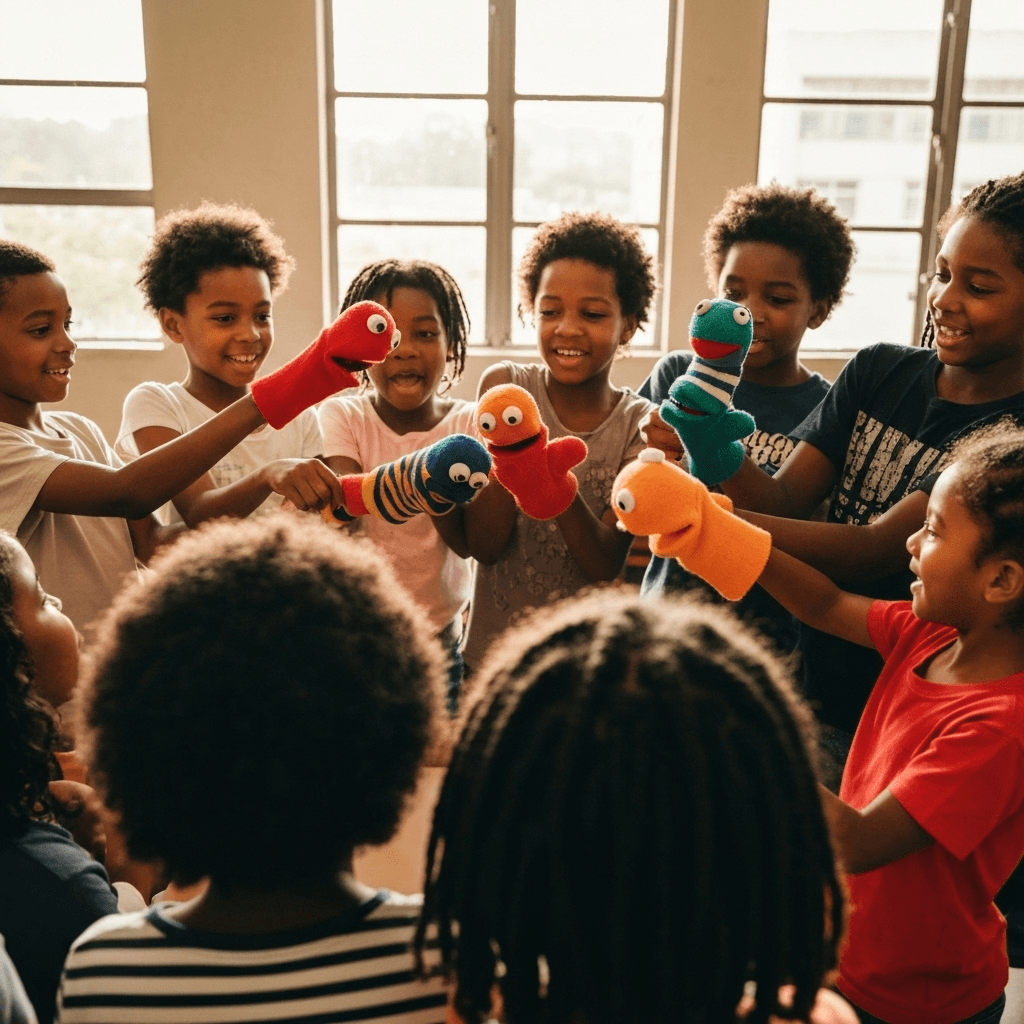Puppet Show Storytelling
A creative speaking and listening activity where students use puppets to retell stories and develop oral language skills through dramatic play.
Activity Overview
Puppet Show Storytelling transforms students into confident storytellers by providing them with puppet characters to bring stories to life. This engaging activity combines oral language development with creative expression, allowing students to retell familiar stories or create original narratives. The puppets serve as a bridge between the student and audience, often helping shy students find their voice while providing all students with a fun, interactive way to practice speaking skills, story structure, and dramatic expression.

Learning Outcomes
- Develop oral language skills through storytelling and character dialogue
- Practice story structure and narrative sequencing
- Build confidence in speaking to an audience
- Enhance creativity through character development and plot creation
- Improve listening skills as audience members
- Develop dramatic expression and voice modulation
- Strengthen memory and recall through story retelling
Curriculum Connections
ELO 1: Learners will speak and listen to explore, extend, clarify and reflect on their thoughts, ideas, feelings and experiences.
- SCO 1.1: Communicate information and ideas effectively
- SCO 1.2: Listen critically to others' ideas
- SCO 1.3: Use speaking and listening to interact with others
ELO 2: Learners will comprehend and respond personally and critically to oral, print, and other media texts.
- SCO 2.1: Experience various texts
- SCO 2.3: Demonstrate comprehension of texts
- SCO 2.4: Respond to texts
Implementation Steps
1Puppet Theater Setup (10 minutes)
- Set up puppet theater or designated performance area
- Arrange audience seating in a semicircle for good viewing
- Display various puppets (stick, sock, finger, hand puppets)
- Prepare story props and simple backdrops if needed
- Create story planning sheets for students to organize ideas
2Story Selection and Planning (15 minutes)
- Choose familiar stories for retelling or encourage original creation
- Help students select appropriate puppets for their characters
- Guide story planning using beginning-middle-end structure
- Practice character voices and puppet movements
- Discuss audience engagement techniques (eye contact, clear speech)
3Rehearsal Time (15-20 minutes)
- Allow students to practice with partners or small groups
- Provide coaching on puppet manipulation and voice projection
- Help students work through story sequence and dialogue
- Encourage experimentation with different character voices
- Support students in timing their performances appropriately
4Performance Time (20-25 minutes)
- Create a supportive, encouraging performance atmosphere
- Have students introduce their puppet show and characters
- Encourage audience participation through appropriate responses
- Celebrate each performance with positive feedback
- Take photos or videos (with permission) to document learning
5Reflection and Discussion (10 minutes)
- Discuss what made each puppet show engaging and effective
- Reflect on story elements: characters, setting, problem, solution
- Share favorite moments and creative storytelling techniques
- Connect puppet show experiences to reading and writing
- Plan future puppet show themes or story ideas
Puppet Show Formats
Story Retellings
Use puppets to retell familiar fairy tales, fables, or classroom read-alouds, focusing on story structure and key events.
Original Adventures
Create new stories with puppet characters, encouraging creativity and original plot development.
Problem-Solution Shows
Develop puppet shows around common childhood problems, exploring solutions through character interactions.
Curriculum Connections
Integrate content learning by creating shows about science concepts, historical events, or math problems.
Differentiation Strategies
For Students Who Excel
- Challenge them to create complex, multi-character stories
- Encourage use of advanced vocabulary and descriptive language
- Have them help direct or coach other students' performances
- Introduce elements like dialogue, conflict resolution, and character development
For Students Who Need Support
- Start with very familiar, simple stories
- Provide sentence starters or story templates
- Allow partnership performances for additional support
- Use picture prompts to help with story sequencing
- Accept shorter performances and celebrate participation
For Shy Students
- Allow practice with just the teacher or a trusted friend first
- Use the puppet as a "brave voice" to reduce anxiety
- Offer alternative roles like narrator or prop manager
- Create smaller audience groups initially
Puppet Types and Uses
Sock Puppets
Easy to make and manipulate, perfect for character creation and expression practice.
Stick Puppets
Simple to create from drawings, ideal for story retellings and quick character changes.
Finger Puppets
Great for small group work and individual practice, less intimidating for shy students.
Hand Puppets
More advanced manipulation, excellent for developing fine motor skills and expression.
Shadow Puppets
Unique visual experience, great for exploring light and shadow while storytelling.
Creating a Supportive Performance Environment
Audience Guidelines
- Listen respectfully and quietly during performances
- Show appreciation through appropriate applause
- Give positive feedback focusing on effort and creativity
- Ask thoughtful questions about the story or characters
- Respect different storytelling styles and approaches
Performance Tips
- Speak clearly and project your voice
- Make your puppet "look" at the audience
- Use different voices for different characters
- Move your puppet to match the action in the story
- Have fun and let your creativity shine
